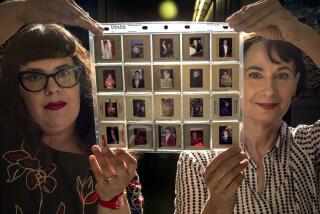Professor First in Line for Scroll Copies
- Share via
Robert Eisenman, head of religious studies at Cal State Long Beach, filled out a simple one-page application at 11:05 a.m. Wednesday, becoming the first scholar to formally request a look at the Huntington Library’s previously secret photographs of the Dead Sea Scrolls.
Officials at the San Marino institution, who announced last weekend that the prized collection would be open to all scholars, told Eisenman that microfilm copies of the photos were not yet ready for viewing but that he was first on the list to be notified when they are.
Eisenman is among dozens of scholars who have been trying vainly for years to gain access to copies of the ancient Jewish documents. The scrolls and photos of them have been shielded from the eyes of all but a handful of favored scholars and their proteges who have been in charge of their translation over the past 40 years. Scholars outside the inner circle have protested that the official team has obstructed access and moved at a glacial pace in producing translations and commentaries.
The 2,000-year-old documents, written by 500 or more scribes, chronicle much of the background of Judaism and Christianity.
Long a crusader for open access, Eisenman wants to view texts related to his current research projects.
“I’d like to look at the Damascus fragments and the so-called ‘Son of God’ text,” he said as he handed in his application.
So would other scholars, such as Michael Wise of the University of Chicago.
He said the Aramaic “Son of God” text is contained on one intact scroll that has two columns of writing, each nine lines long. But only a couple of tantalizing lines have been made public.
The scroll describes a figure about whom it is said: “He shall be called the Son of God. They shall call him the Son of the Most High,” Wise said in a telephone interview.
Eisenman and Wise said they want to see what that means in the context of the whole document. To whom is it referring? Was the document in existence in Judaism at the time Jesus was born? Was the writer of Luke’s gospel influenced by the scrolls?
“That’s where I’d want to begin,” said Wise, adding that he is ready to hop on a plane to Southern California on a moment’s notice.
Norman Golb, professor of Jewish history at the University of Chicago’s Oriental Institute, said he is intrigued by the one copper scroll found among the 800 documents. It describes where scrolls and treasurers are hidden, he said, and probably dates back to the days of the Temple in Jerusalem and was moved to a Qumran cave because the Jews feared that the city would be attacked by Rome in the winter of AD 70.
The scrolls will provide better historical data about the times in which they were written, Golb said.
Refused permission to see the texts in 1970, Golb said that access now would “advance my stymied work.”
Huntington Director William A. Moffett said the library’s microfilm copies needed editing “by scholars in the field to clean up any errors” in labeling before they are released.
“We’re not going to be in a great rush,” he added. “We’ve waited 40 years, for God’s sake. . . .” In addition to viewing at the Huntington, microfilm copies will be made available to scholars worldwide who request to see them at local libraries.
Eisenman takes credit for spearheading an effort by American Jewish scholars to press for even wider access.
He and Golb drafted a letter signed by other influential Jewish scholars engaged in manuscript studies, and sent it Tuesday to Zevulon Hammer, the Israeli minister of education.
In the letter, the American scholars said they deplored the Israel Antiquities Authority’s threat of legal action against the Huntington for opening its scrolls collection and feared that litigation would “further erode Israel’s position in the public opinion, and in particular, the U.S.A. . . .
“We know that when Israel seriously considers this matter they will not come down on the side of parochialism, but on the side of free scholarship for all, which should have been their position from the beginning and which continues to be the guiding light for all Jewish scholars everywhere,” the letter said.
At a hastily called press conference in the Huntington’s gardens, Eisenman read the letter and a response he received on Wednesday from the Israeli minister of science, Yuval Ne’eman.
Ne’eman’s letter said he would “do his best” to urge the Antiquities Authority not to interfere and asserted that “every scholar should be granted free access to examine the scrolls and publish his findings.”
More to Read
Sign up for Essential California
The most important California stories and recommendations in your inbox every morning.
You may occasionally receive promotional content from the Los Angeles Times.













